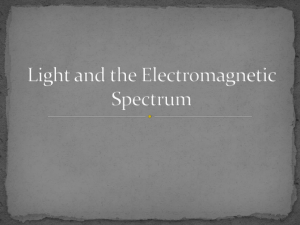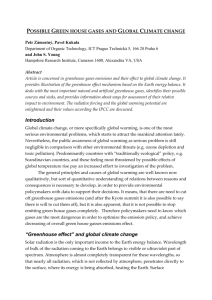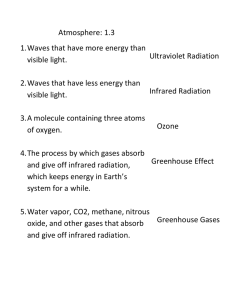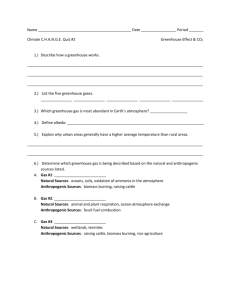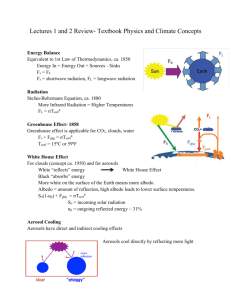The Greenhouse Effect (text p. 20-31)
advertisement
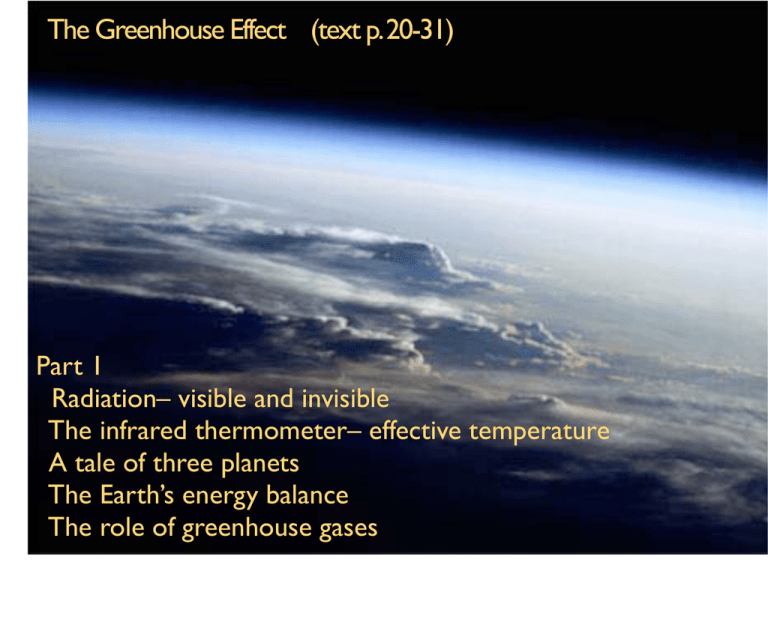
The Greenhouse Effect (text p. 20-31) Part 1 Radiation– visible and invisible The infrared thermometer– effective temperature A tale of three planets The Earth’s energy balance The role of greenhouse gases Topics from the outline that we’ll be covering this week Sensitivity Tipping Points Global Warming Feedbacks Greenhouse Effect What is a Greenhouse Gas? Natural Sources Buildup of Greenhouse Gases Anthropogenic Sources Radiation– visible and invisible Waves (or particles) that transmit energy in a specific direction It’s the only way of transmitting energy through a vacuum Matter emits and absorbs radiation The higher the (absolute) temperature of a body the more radiation it emits (S-B) the shorter the wavelength of the emitted radiation S-B: Stefan-Boltzmann law WDL: Wien displacement law (WDL) As a fire dies, the peak of the emitted radiation shifts toward longer wavelengths; the yellow and orange disappear first and the last to go is the deep red. Even after the visible radiation disappears, the hot ashes continue to emit infrared radiation that you can feel if you are close to it. The infrared thermometer– effective temperature measures emitted radiation converts it to an “effective temperature” scale Thermal infrared imaging measures emitted radiation displays it on color or gray scale Examples of infrared imagery: warm colors denote high emission and vice versa. Thermal infrared imaging The Earth viewed with infrared imagery. The yellow patches in the tropics are clouds with cold tops. The deserts show up clearly as hot spots. This figure is added to help you interpret the infrared image in the previojus slide. High clouds are rendered in pure white; low clouds in off-white. The infrared thermometer– effective temperature radiation flux Watts per square meter measures emitted radiation converts it to an “effective temperature” scale Temperature (K) The infrared thermometer– effective temperature radiation flux Watts per square meter measures emitted radiation converts it to an “effective temperature” scale Temperature (K) The infrared thermometer– effective temperature radiation flux Watts per square meter measures emitted radiation converts it to an “effective temperature” scale Temperature (K) The infrared thermometer– effective temperature radiation flux Watts per square meter measures emitted radiation converts it to an “effective temperature” scale Temperature (K) Earth’s effective temperature (measured from satellite) 255 K –18°C 0°F Just for comparison, Earth’s surface temperature (measured with thermometers) 288 K +15°C 60°F A tale of three planets Earth upper left; Venus below it; Mars to the right. The sizes are not to scale. Inverse square law 1.56 AU F = 592 W / sq. m 1.00 AU F = 1380 W / sq. m 0.72 AU F = 2639 W / sq. m 1.00 0.72 1.52 Distance from sun 1380 2639 592 Watts per square meter of solar radiation Reflected / Incoming = Albedo 0.30 0.78 0.17 Albedo Text Emitted flux = 1/4 x (1– Albedo) x solar flux = 1/4 x (1.00 – 0.30) 1368 = 239 watts per square meter Emitted flux = 1/4 x (1– Albedo) x solar flux = 1/4 x (1.00 – 0.30) 1368 = 239 watts per square meter If we know the emitted flux, then we know the effective temperature Greater distance from the sun favors a lower effective temperature A higher albedo favors a lower effective temperature 255 K 225 K 216 K Effective temperature 255 K 225 K 216 K Venus has a lower effective temperature than Earth because it has a high albedo. 288 K 737 K 210 K Surface temperature Venus Earth Mars Ts 737 288 210 TE 225 255 216 Ts – TE 527 33 –6 Why is Ts different from TE ? Why is Ts – TE so different for different planets Answer: The greenhouse effect The Earth’s energy balance Reconsider the Earth’s energy balance taking the role of the atmosphere into account. We’ve already accounted for the contribution of clouds to the albedo... ... but not the effect of gas molecules in absorbing energy emitted from below and reemitting some of it back downwards toward the surface In other words, gas molecules block some of the outgoing infrared radiation. They thus warm the Earth’s surface, much as a blanket warms a sleeper. If the atmosphere had no GHG, clouds, or aerosols, infrared radiation would pass through it without being absorbed. But if we suddenly cover the Earth with an atmosphere, most of the radiation emitted by the Earth’s surface gets absorbed, and only a small fraction passes through. The atmosphere emits the radiation it absorbs. Most of it is emitted downward, back towards the Earth’s surface. The downward flux of infrared radiation from the atmosphere makes the Earth’s surface warm up, and as it gets warmer it emits more radiation Eventually the system (Earth + atmosphere) comes into equilibrium. The Earth’s surface has been warmed by the addition of an atmosphere. This is the essence of the greenhouse effect. Incoming radiation alone Balance between incoming and outgoing energy Incoming radiation alone The greenhouse effect Balance between incoming and outgoing energy 1 0.01 92 Atmospheric mass Comparison of the mass per unit area of the atmospheres of Venus, Earth, and Mars. Venus has a massive atmosphere composed mainly of a strong greenhouse gas (CO2) which gives rise to a very strong greenhouse effect. The greenhouse effect is real. Without it, Earth would be uninhabitable 1 Atmospheric mass but it’s possible to have too much of a good thing Earth Portal, Encyclopedia of Earth The greenhouse effect would make the Earth’s surface even warmer than 288 K were it not for evaporation and heat transfer by conduction. A more detailed rendition of the surface energy balance. This was not explained in class.

